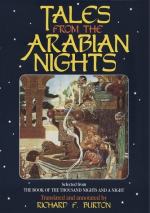[FN#207] This story appears familiar, but I have not found it easy to trace. In “The Book of Sindibad” (p. 83) it is apparently represented by a lacuna. In the Squire’s Tale of Chaucer Canace’s ring enables the wearer to understand bird-language, not merely to pretend as does the slave-boy in the text.
[FN#208] The crow is an ill-omened bird in Al-lslam and in Eastern Christendom. “The crow of cursed life and foul odour,” says the Book of Kalilah and Dimna (p. 44). The Hindus are its only protectors, and in this matter they follow suit with the Guebres. I may note that the word belongs to the days before “Aryan” and “Semitic” speech had parted; we find it in Heb. Oreb; Arab. Ghurab; Lat. Corvus; Engl. Crow, etc.
[FN#209] Again in the Hibernian sense of being “kilt.”
[FN#210] Quoted in Night dlxxxii.; said by Kitfir or Itfir (Potiphar) when his wife (Rail or Zulaykha) charged Joseph with attempting her chastity and he saw that the youth’s garment was whole in front and rent in rear. (Koran, chapt. xii.)
[FN#211] This witty tale, ending somewhat grossly here, has over-wandered the world. First we find it in the Katha (S. S.) where Upakosha, the merry wife of Vararuchi, disrobes her suitors, a family priest, a commander of the guard and the prince’s tutor, under plea of the bath and stows them away in baskets which suggest Falstaff’s “buck-basket.” In Miss Stokes’ “Indian Fairy Tales” the fair wife of an absent merchant plays a similar notable prank upon the Kotwal, the Wazir, the Kazi and the King; and akin to this is the exploit of Temal Ramakistnan, the Madrasi Tyl Eulenspiegel and Scogin who by means of a lady saves his life from the Rajah and the High Priest. Mr. G. H. Damant (pp. 357-360 of the “Indian Antiquary” of 1873) relates the “Tale of the Touchstone,” a legend of Dinahpur, wherein a woman “sells” her four admirers. In the Persian Tales ascribed to the Dervish “Mokles” (Mukhlis) of Isfahan, the lady Aruya tricks and exposes a Kazi, a doctor and a governor. Boccaccio (viii. 1) has the story of a lady who shut up her gallant in a chest with her husband’s sanction; and a similar tale (ix. 1) of Rinuccio and Alexander with the corpse of Scannadeo (Throkh-god). Hence a Lydgate (circ. A.D. 1430) derived the plot of his metrical tale of “The Lady Prioress and her Three Sisters”; which was modified in the Netherlandish version by the introduction of the Long Wapper, a Flemish Robin Goodfellow. Followed in English the metrical tale of “The Wright’s Chaste Wife,” by Adam of Cobham (edited by Mr. Furnivall from a Ms. of circ. A.D. 1460) where the victims are a lord, a steward and a proctor. See also “The Master-Maid” in Dr. (now Sir George) Dasent’s “Popular Tales from the Norse,” Mr. Clouston, who gives these details more fully, mentions a similar Scottish story concerning a lascivious monk and the chaste wife of a miller.
[FN#212]When Easterns sit down to a drinking bout, which means to get drunk as speedily and pleasantly as possible, they put off dresses of dull colours and robe themselves in clothes supplied by the host, of the brightest he may have, especially yellow, green and red of different shades. So the lady’s proceeding was not likely to breed suspicion: al- though her tastes were somewhat fantastic and like Miss Julia’s—peculiar.




